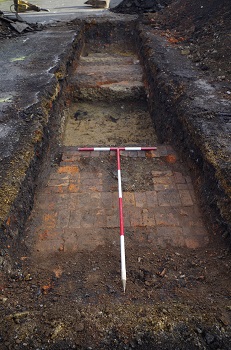N Williams and Co, Victoria Street, Southampton. Archaeological Evaluation. (SOU1739) (OASIS ID: wessexar1-274690)
Wessex Archaeology, 2018. https://doi.org/10.5284/1047210. How to cite using this DOI
Data copyright © Wessex Archaeology unless otherwise stated
This work is licensed under the ADS Terms of Use and Access.
Primary contact
Jennifer
Whitby
Archives Technician
Wessex Archaeology
Portway House
Old Sarum Park
Salisbury
SP4 6EB
UK
Resource identifiers
- ADS Collection: 3053
- DOI:https://doi.org/10.5284/1047210
- How to cite using this DOI
Introduction

Wessex Archaeology was commissioned by Wildern Architecture Ltd on behalf of Williams and Co (Southampton) Ltd to undertake an archaeological evaluation ahead of the proposed redevelopment of N Williams and Co, Victoria Street, Southampton. The evaluation comprised two trenches measuring 8.7 m by 2.1 m (trench 1) and 10.8 m by 1.6 (trench 2) on the locations of proposed new foundations.
A broadly consistent stratigraphic sequence was recorded in each trench, comprising modern tarmac overlying demolition deposits, and brick and concrete foundations relating to terrace housing dating to the late 19th century. These overlay ground raising and levelling deposits, above estuarine alluvium with some degree of soil formation at its top. The thin soil at the top of the alluvium appears likely to have formed after the embankment and drainage of the area, when the land would still have comprised periodically wet ground. The reclamation of Northam Marsh, which extended to the north of the site, is likely to have taken place progressively through the post-medieval period, suggesting that upper alluvium/soil is probably similarly late.
The observed sequences, therefore, probably only span a few hundred years from the post-medieval period into the first half of the 19th century. This would help explain why this particular area, which was relatively low-lying, was the latest to be built on in the late 19th century. The terrace housing on Victoria Street is first portrayed on the 2nd edition OS map of 1898. In the mid-Saxon period the marsh would have acted as a barrier to Hamwic's development towards the north-east. For this reason, it would seem unlikely that there are any Hamwic-related deposits in or below the alluvium, which was recorded to a depth of over 1.8 m below ground level within the site. No finds other than late post-medieval and modern material was present.





